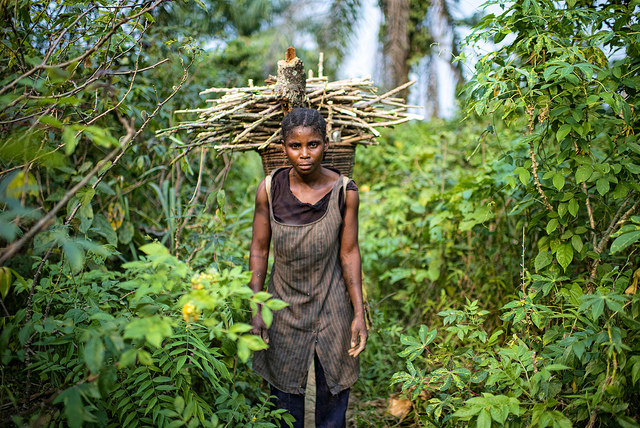
Recent global assessments suggest that more than 40 percent of agricultural land –about 1 billion ha—has a tree cover of 10 percent. This land is home to 900 million people, and close to a third of the household income is derived from forest resources by smallholders living at the forest margin.
Our central hypothesis is that food security, nutrition and income of 100 million people in smallholder households in Africa, Asia and Latin America can be significantly improved when tree and forest resources are better managed.
Our research aims to increase the contribution that trees and forests make to smallholder livelihoods by
- developing more productive tree management options,
- helping smallholders earn more from the sale of products and
- ensuring more equitable management of tree and forest resources.
This will give smallholder families better access to diverse, nutrient-rich foods and increase livelihood opportunities especially for those who are socially and economically marginalized.
We focus on the challenge of providing food, water and energy for a growing population, while halting and reversing land degradation that threatens future productivity. Our research will lead sustainable food security and income for 100 million people who represent about 11 percent of the population living in our target area.
Novel approaches
Our central focus is at the household level and–together with development partners –we apply a ‘research in development’ (RinD) paradigm, to tailor solutions to different contexts.
Options may comprise combinations of technologies, market and extension interventions, and policy instruments, which often interact with one another in improving livelihoods. The Flagship devotes a quarter of the budget to novel methods of conducting research in cooperation with development partners.
The Flagship has been reorganized into five research clusters. This enables integrative research to be carried out on livelihood systems analysis, synthesis and scaling, to structure the work across major types of tree production that underpin smallholder livelihoods:
- timber,
- food and fuel production and marketing;
- tree-crop commodities (e.g. coffee, cocoa, oil palm and rubber);
- trees in support of sustainable intensification; and
- silvopastoral systems.
The research includes a wide range of beneficiaries, from subsistence farmers focused on increasing the yield of staple crops in East and Southern Africa, through often migrant cocoa and coffee smallholders who want to commercialize in conditions of uncertain land tenure and prices in West Africa, smallholders marketing timber and other products at forest margins in the Amazon and Indonesia, to cattle-keepers in Central America.

Clusters of Activities
1) Livelihood systems analysis, synthesis and scaling
This cluster develops and applies approaches, methods and tools aimed at identifying opportunities for change, trade-offs and negotiation between agricultural, nonagricultural elements and forest elements of rural livelihoods.
Key research questions are:
- How can we most efficiently, effectively and equitably co-develop design principles for matching options that improve the use of trees and forests by smallholders to the fine-scale variation in the context of smallholder livelihood systems?
- How can scientific information be used to support negotiation among stakeholders, bridging farm to local landscape scales to manage the impacts of land-use change on ecosystem service provision?
- What are the political and institutional conditions that allow for household and smallholder success in terms of livelihood improvements, including ways to scale-up the results from interventions?
2) Smallholder timber, food and fuel production and marketing
In this cluster, we examine the prospect of enhancing smallholder livelihoods by better production and marketing of these products on farms and investigate the impacts of different forms of forest management on livelihood outcomes.
This contrasts with Flagship 4, which looks at forest management from the perspective of managing, maintaining and regenerating ‘forests’ for multiple purposes.
Key research questions are:
- How can barriers be removed to smallholders accessing markets for tree and forest products, allowing them to capture more of their value, especially for people who are socially or economically marginalized?
- What types of products and markets are most suitable and what interventions are most cost effective to realize these outcomes?
- How can smallholders profitably produce and market quality timber on a small scale?
3) Developing and sustaining smallholder tree-crop commodity production
This research contributes to increasing livelihood opportunities through diversification of monocultures and closure of yield gaps by sustainable intensification focused on agronomic management, including planting materials, pruning and fertilization.
Key research questions are:
- How can smallholder tree-crop commodity production systems be sustainably managed in the face of climate change, price volatility, declining yield and soil fertility following forest conversion, coupled with constraints on opening new forest areas, and those imposed by the dynamics of migration?
- What is required in terms of an enabling environment to switch from unsustainable monocultures to more diverse and resilient production practices?
4) Trees supporting sustainable agro-ecological intensification
The overarching hypothesis is that the establishment and better management of tree cover in crop fields and farmsteads can increase and sustain soil health and crop yields while contributing to system intensification through provision of fodder and fuelwood on farms.
Key research questions are:
- What are the optimum levels of tree density and diversity in different contexts required to increase total productivity of smallholder livelihood systems while conferring resilience at farm and landscape scales?
- How can we effectively promote the desired density and diversity of trees on farmland?
- What is the relationship between tree cover and soil health and where are there trade-offs and synergies between production goals and the provision of other ecosystem services?
5) Sustaining silvo-pastoral systems for production, animal welfare and the environment
The overarching hypothesis is that establishment and better management of tree cover on pastures can contribute simultaneously to higher livestock productivity, animal welfare and biodiversity conservation as well as restoring degraded rangelands and avoiding future degradation.
Key research questions:
- What is the relationship between tree cover (density and diversity) and pasture and animal productivity and welfare in silvo-pastoral systems?
- Where are there trade-offs and synergies between production goals and the provision of other ecosystem services?
